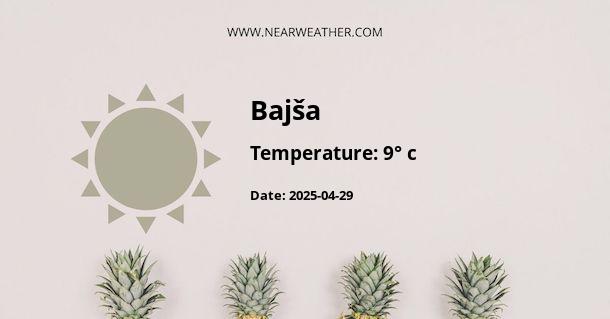Understanding the Climate and Weather in Bajša, Republic of Serbia
Welcome to Bajša, a charming locality nestled in the autonomous province of Vojvodina within the Republic of Serbia. Understanding the climate and weather patterns of Bajša is vital for travelers, agricultural planning, and daily activities of the residents. In this comprehensive overview, we will delve into the climatic characteristics of this region, providing insights supported by meteorological data and expert analysis.
Geographical Context of Bajša
Before we examine the weather specifics, let's place Bajša on the map. Situated in the northern reaches of the country, Bajša experiences a modified continental climate. This classification is characterized by warm summers and cold winters, without any extreme temperature fluctuations as often seen in the true continental climate zones further east.
Climatic Features of Bajša
The climatic regime of Bajša can be dissected into several components:
- Temperature: Seasonal variations in temperature are significant, with warm summers and cold winters.
- Precipitation: Rainfall is fairly evenly distributed throughout the year, albeit with a slight peak in late spring to early summer.
- Sunshine: The region enjoys a generous number of sunshine hours, especially during the summer.
- Wind: Winds are also a distinguishing feature, with the Košava - a cold and blustery southeast wind - influencing the local weather.
Seasonal Weather Patterns
Let’s break down the seasonal weather patterns one might expect in Bajša:
Spring
Spring in Bajša sees a gradual increase in temperatures with the melting away of winter’s chill. The season welcomes more frequent precipitation, fostering the blooming of local flora.
Month
Average High (°C)
Average Low (°C)
Precipitation (mm)
March
12
2
40
April
18
7
50
May
23
12
60
As spring progresses, locals prepare for the agricultural tasks ahead, mindful of the possible late frosts in early spring that can affect crops.
Summer
Summers in Bajša are typically warm, with temperatures peaking in July and August. Occasional heatwaves can raise temperatures significantly, which is a concern for vulnerable populations and agriculture.
Month
Average High (°C)
Average Low (°C)
Precipitation (mm)
June
26
15
75
July
29
17
65
August
29
17
55
Despite the heat, summer is a lively season in Bajša, with residents making the most of the long daylight hours for various outdoor activities and festivals.
Autumn
Autumn brings a noticeable cool down and a gradual decrease in daylight. The season is marked by harvesting and the preparation for winter, both in agricultural and urban-settlement contexts.
Month
Average High (°C)
Average Low (°C)
Precipitation (mm)
September
24
13
55
October
18
8
50
November
11
3
60
Autumn rainfalls contribute to the replenishment of water resources, which can be stressed during the dry summer months.
Winter
Winters in Bajša are characterized by cold temperatures, although extreme cold is mitigated compared to regions further from the Atlantic. Snowfall can occur, but heavy snow is not a regular feature every year.
Month
Average High (°C)
Average Low (°C)
Precipitation (mm)
Snowfall (cm)
December
5
-1
50
15
January
3
-3
40
20
February
5
-2
35
15
During winter, the Košava wind can lead to significantly lower felt temperatures, adding a biting chill to the air.
Extreme Weather Events and Climate Change
In recent years, like many parts of the world, Bajša has not been immune to the impacts of climate change. The region has faced unusual weather phenomena such as uncharacteristic heatwaves in the summer and milder winters. Extreme weather events, including heavy rainfalls causing floods, have grown more frequent. Climate scientists predict that unless significant global action is taken, these irregular patterns may become the norm.
Preparedness and Adaptation Strategies
Residents and local authorities in Bajša are increasingly aware of the need to adapt to changing climate conditions. Preparedness strategies include enhancing infrastructure resilience, adopting sustainable agricultural practices, and promoting water conservation techniques.
"As someone who has studied the weather patterns in Serbia for decades, I can attest that the climate in Bajša has become more unpredictable over the last few years. Proactive adaptation measures are essential to mitigate the risks associated with these changes." - Dr. Ivan Pavlović, Meteorologist and Climate Scientist
Conclusion
In sum, Bajša, RS, displays a continental climate with a gentle mix of Mediterranean influences. The weather throughout the year ranges from snowy, cold winters to hot, sunny summers. With climate change shaping the future's weather patterns, Bajša must adapt and prepare for a wide array of weather phenomena. Understanding these patterns is key to thriving in this dynamic climatic landscape.
By keeping informed with accurate, up-to-date weather forecasts and climate research, the citizens of Bajša, and those with an interest in the region, can navigate the changing seasons effectively. This detailed climatological snapshot aims to serve as a guide to all those who wish to deeply understand the intricate weather tapestry of Bajša, Serbia.
A - Bajša's Latitude is 45.779171 & Longitude is 19.584999.
A - Weather in Bajša is 9° today.
A - Climate Conditions in Bajša shows clear sky today.
A - Humidity in Bajša is 72% today.
A - Wind speed in Bajša is 9.68 km/h, flowing at 121° wind direction. today.
